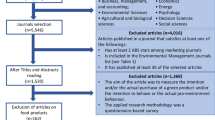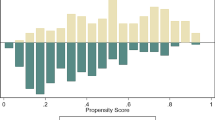Abstract
This paper is concerned with the use of thechoice experiment method for modelling thedemand for recreation, using the example ofrock-climbing in Scotland. We begin byoutlining the method itself, including itstheoretical and econometric underpinnings. Datacollection procedures are then outlined. Wepresent results from both nested and non-nestedmodels, and report some tests for theimplications of choice complexity andrationality. Finally, we compare our resultswith a revealed preference data model based onthe same sample of climbers.
Similar content being viewed by others
References
Adamowicz, W., J. Louviere and M. Williams (1994), ‘Combining Revealed and Stated Preference Methods for Valuing Environmental Amenities’, Journal of Environmental Economics and Management 26, 271–292.
Adamowicz W., J. Swait, P. Boxall, J. Louviere and M. Williams (1997), ‘Perceptions Versus Objective Measures of Environmental Quality in Combined Revealed and Stated Preference Models of Environmental Valuation’, Journal of Environmental Economics and Management 32, 1, 52–64.
Adamowicz, W., P. Boxall, M. Williams and J. Louviere (1998), ‘Stated Preference Approaches to Measuring Passive Use Values: Choice Experiments Versus Contingent Evaluation’, American Journal of Agricultural Economics 80(1), 64–75.
Allenby, G., N. Arora and J. Ginter (1995), ‘Incorporating Prior Knowledge into the Analysis of Conjoint Studies’, Journal of Marketing Research 32, 152–162.
Ben-Akiva, M. and S. Lerman (1985), Discrete-Choice Analysis: Theory and Application to Travel Demand. Cambridge, MA: MIT Press.
Bhat, C. R. (1995), ‘A Heteroskedastic Extreme Value Model of Intercity Travel Mode Choice’, Transportation Research B 29(6), 471–483.
Boxall P., W. Adamowicz, J. Swait, M. Williams and J. Louviere (1996), ‘A Comparison of Stated Preference Methods for Environmental Valuation’, Ecological Economics 18, 243–253.
Bullock, C. H., D. A. Elston and N. A. Chalmers (1998), ‘An Application of Economic Choice Experiments to a Traditional Land Use – Deer Hunting and Landscape Change in the Scottish Highlands’, Journal of Environmental Management 52(4), 335–351.
Cavlovic T. and R. Berrens (1999), ‘A Question of Standing? Institutional Change and Rock Climbing in Wilderness Areas’, mimeo, Department of Economics, University of New Mexico.
Cavlovic T., R. Berrens, A. Bohara, P. Jakus and W. D. Shaw (2000), ‘Valuing the Loss of Rock Climbing Access in Wilderness Areas: A National-level Random Utility Model’, mimeo, Department of Economics, University of New Mexico.
Eisworth M., J. Englin, E. Fadali and W. D. Shaw (2000), ‘The Value ofWater Levels in Water-based Recreation: A Pooled Revealed Preference/Contingent Behaviour Model’, Water Resources Research 36(4), 1079–1086.
Englin J. and T. Cameron (1996), ‘Augmenting Travel Cost Models with Contingent Behaviour Data’, Environmental and Resource Economics 7, 133–147.
Hanley N., R. Wright and W. Adamowicz (1998), ‘Using Choice Experiments to Value the Environment: Design Issues, Current Experience and Future Prospects’, Environmental and Resource Economics 11(3–4), 413–428.
Hanley N., D. MacMillan, R. E. Wright, C. Bullock, I. Simpson, D. Parsisson and B. Crabtree (1998), ‘Contingent Valuation Versus Choice Experiments: Estimating the Benefits of Environmentally Sensitive Areas in Scotland', Journal of Agricultural Economics 49(1), 1–15.
Hanley N., G. Koop, R. Wright and B. Alvarez-Farizo (2001), ‘Go Climb a Mountain: An Application of Recreation Demand Models to Rock Climbing in Scotland', Journal of Agricultural Economics 52(1), 36–52.
Hanley N., S. Mourato and R. Wright (2001), ‘Choice Modelling: A Superior Alternative for Environmental Valuation?’ Journal of Economic Surveys 15(3), 435–462.
Hausman, J. and D. Wise (1978), ‘A Conditional Probit Model for Qualitative Choice: Discrete Decisions Recognising Interdependence and Heterogeneous Preferences’, Econometrica 42, 403–426.
Hausman, J. A. and D. McFadden (1984), ‘Specification Tests for the Multinomial Logit Model’, Econometrica 52, 1219–1240.
Highlands and Islands Enterprise (1996), The Economic Impacts of Hill-walking, Mountaineering and Associated Activities in the Highlands and Islands of Scotland. Inverness: HIE.
Jakus, P. and W. D. Shaw (1996), ‘An Empirical Analysis of Rock-climbers Response to Hazard Warnings’, Risk Analysis 16, 581–585.
Loewenstein, G. (1999), ‘Because It Is There: The Challenge of Mountaineering for Utility Theory’, Kyklos 52, 315–344.
Louviere, J. and D. Hensher (1982), ‘On the Design and Analysis of Simulated Choice or Allocation Experiments in Travel Choice Modelling’, Transportation Research Record 890, 11–17.
Louviere, J. and G. Woodworth (1983), ‘Design and Analysis of Simulated Consumer Choice or Allocation Experiments: An Approach Based on Aggregate Data’, Journal of Marketing Research 20, 350–367.
Luce, R. D. (1959), Individual Choice Behavior: A Theoretical Analysis. New York: John Wiley & Sons.
McFadden, D. (1973), ‘Conditional Logit Analysis of Qualitative Choice Behaviour’, in P. Zarembka, ed., Frontiers in Econometrics. New York: Academic Press.
Shaw, W. D. and P. Jakus (1996), ‘Travel Cost Models of the Demand for Rock Climbing’, Agricultural and Resource Economics Review 25, 133–142.
Thurstone, L. (1927), ‘A Law of Comparative Judgement’, Psychological Review 34, 273–286.
Train, K. E. (1998), ‘Recreation Demand Models with Taste Differences Across People’, Land Economics 74(2), 230–239.
Author information
Authors and Affiliations
Rights and permissions
About this article
Cite this article
Hanley, N., Wright, R.E. & Koop, G. Modelling Recreation Demand Using Choice Experiments: Climbing in Scotland. Environmental and Resource Economics 22, 449–466 (2002). https://doi.org/10.1023/A:1016077425039
Issue Date:
DOI: https://doi.org/10.1023/A:1016077425039




